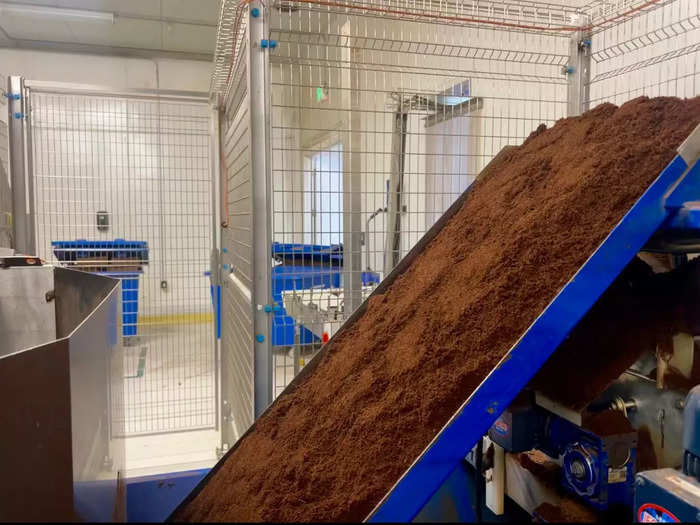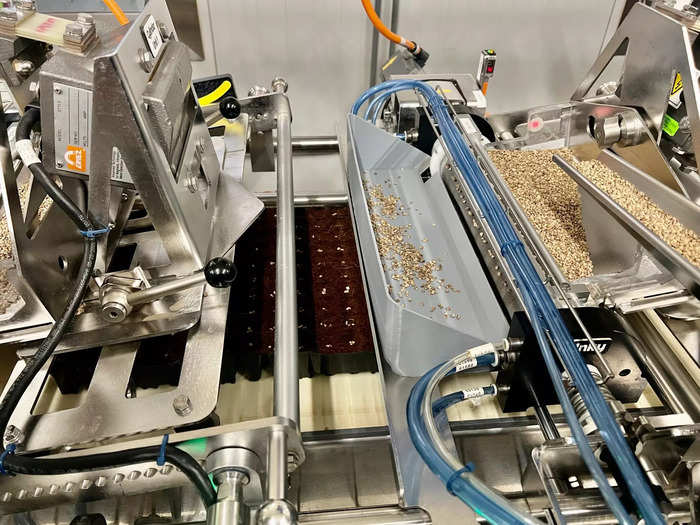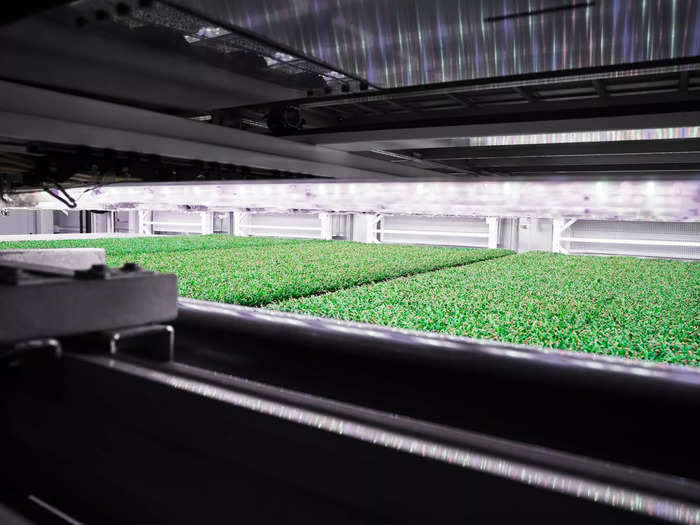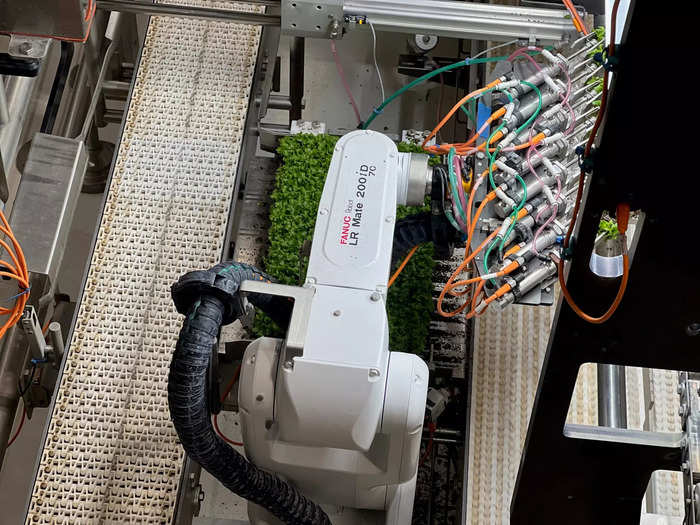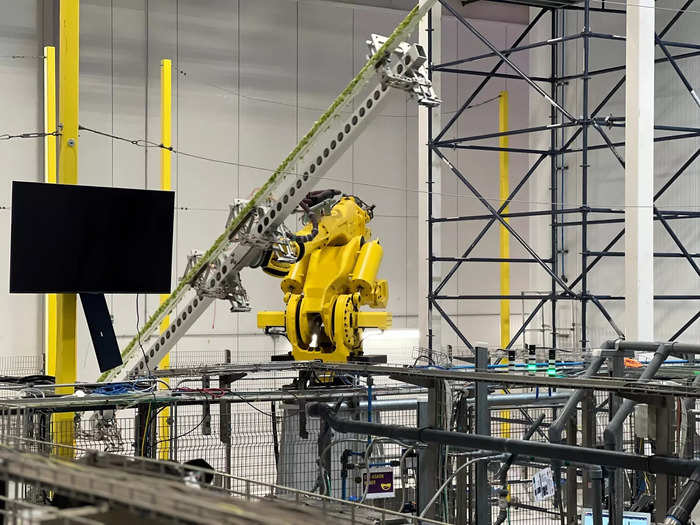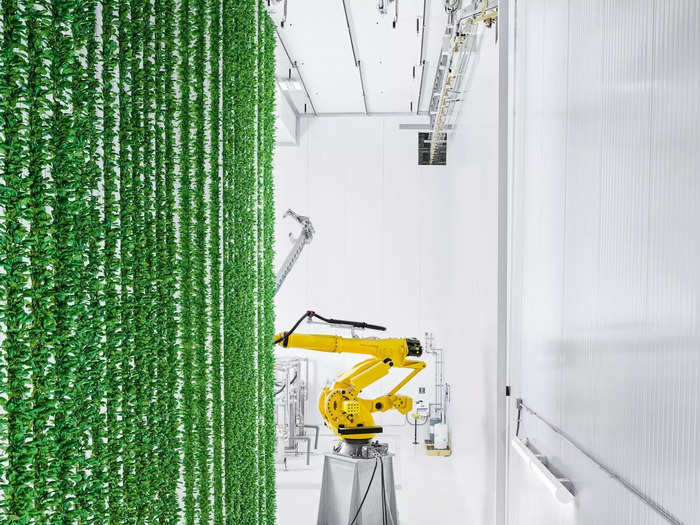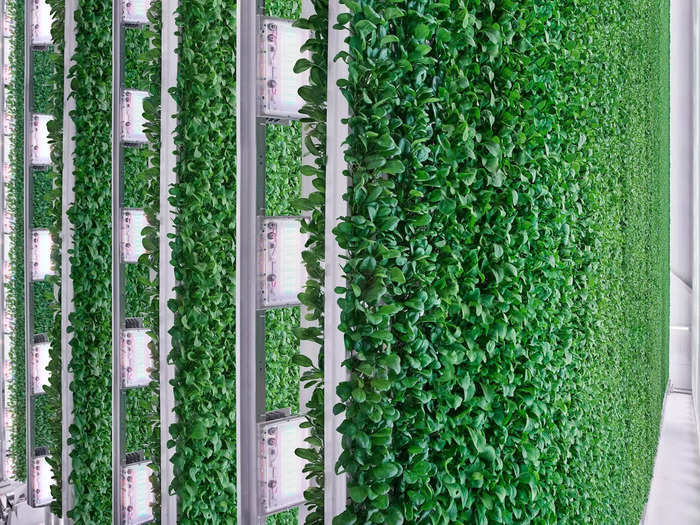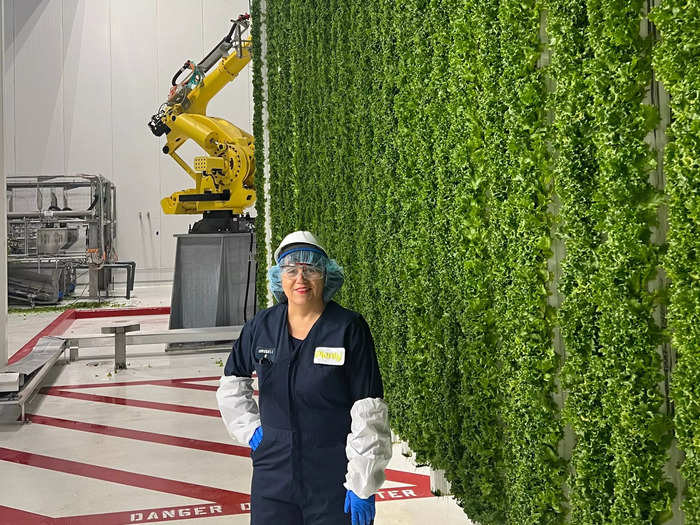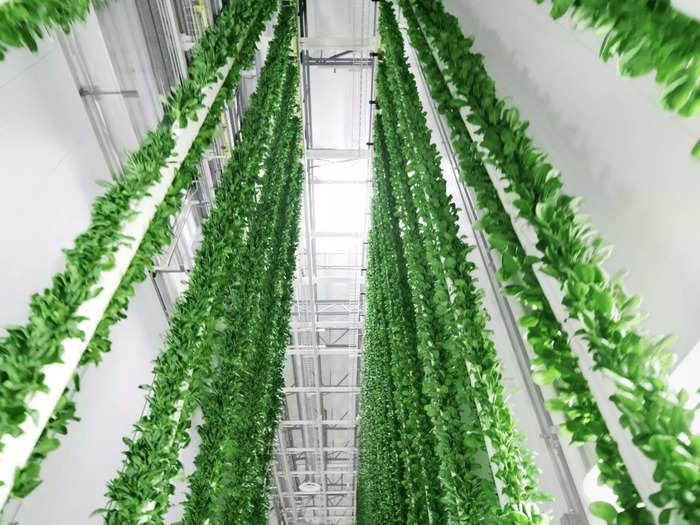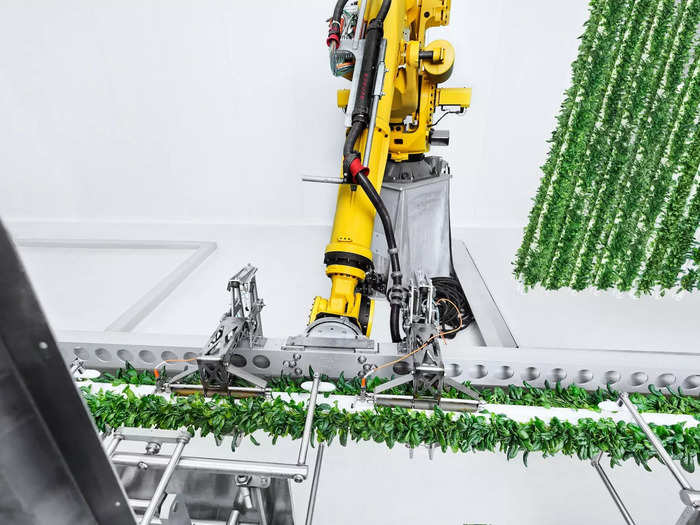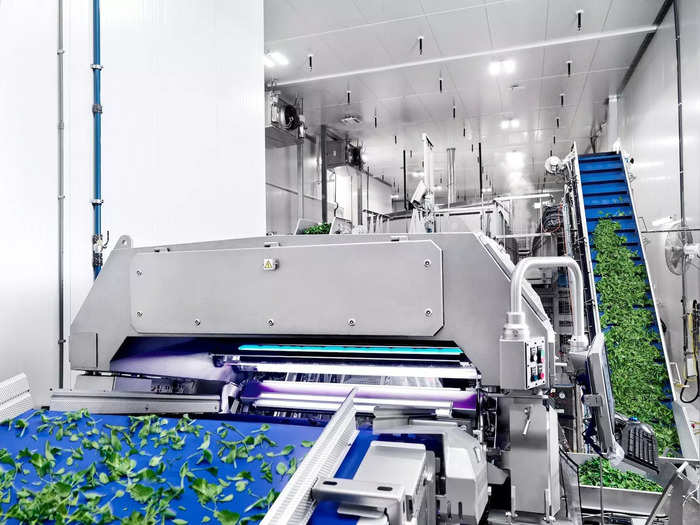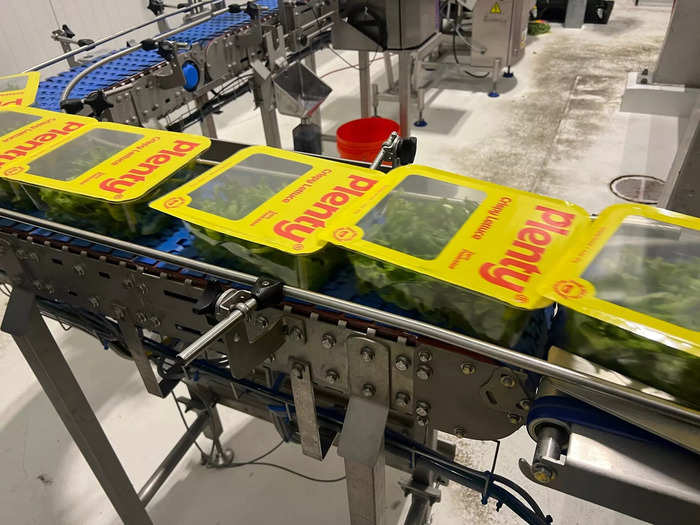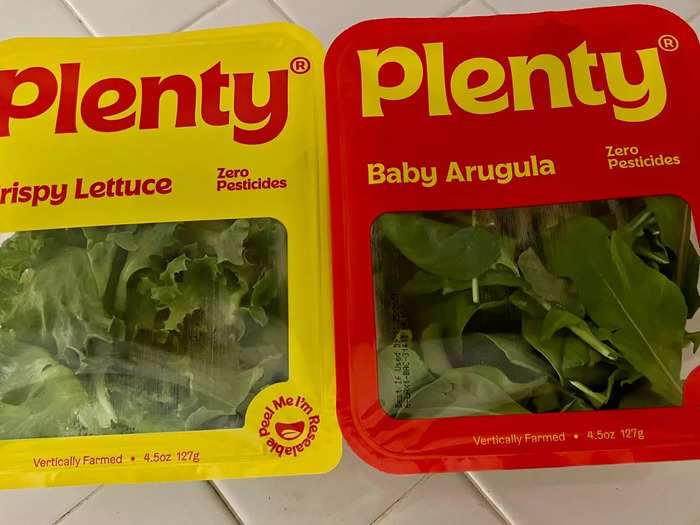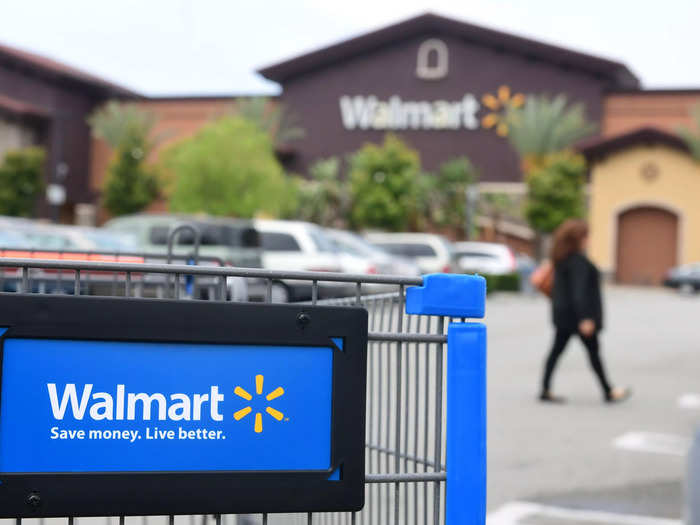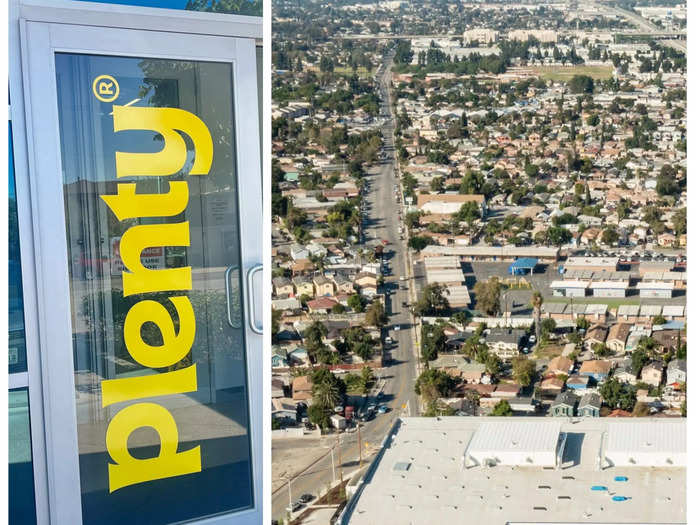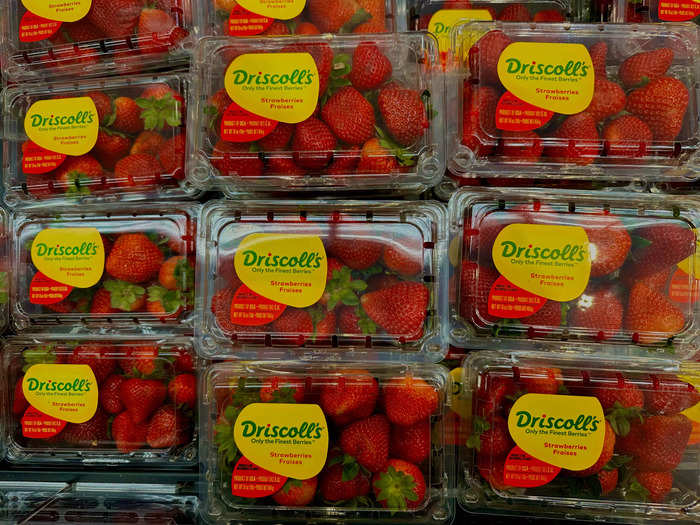Business Insider food correspondent Nancy Luna tours the Plenty vertical farm in Compton, California. Walmart invested in Plenty in 2022, and the urban farm supplies Walmart stores in the Golden State.Business Insider; Plenty
- Ag-tech startup Plenty opened a 100,000-square foot indoor farm in Compton, California this year.
- The urban farm supplies Walmart and Whole Foods with leafy greens. Walmart is an investor.
Your next package of lettuce could be coming straight outta Compton.
Last week, I toured a 100,000-square-foot indoor vertical farm operating in a gritty part of Compton, California. The urban farm run by the Bay Area agricultural-tech startup Plenty is designed to grow up to 4.5 million pounds of leafy greens annually.
Plenty launched the large-scale indoor farm in May, producing leafy greens that can go from harvest to store in 24 hours. The company's produce can be found at high-profile grocery stores in California, including Walmart, Whole Foods, and Bristol Farms. Walmart is also an investor in Plenty.
Over my two-decade career as a food journalist, I've visited farms and processing plants that supply leafy greens for top fast-food chains such as McDonald's.
Farming is one of the most labor-intensive parts of our food supply chain. It requires hundreds of acres of fields and countless workers to produce a variety of leafy greens found in grocery stores and restaurants. After harvest, the greens are shipped miles away to processing plants for washing and packaging.
Plenty, on the other hand, grows, harvests, and packages four types of leafy greens in a single facility. Because it is set in a controlled environment, it is never threatened by excessive rain or heat. Seasonality is immaterial, as Plenty can grow year-round.
What Plenty is doing is groundbreaking.
During my tour, I rarely saw any humans. Automated machinery and robots do most of the work, from planting seeds to harvesting. I only spotted workers during the packaging process. Occasionally, someone popped into a room to check on machinery.
The only thing Plenty had in common with my farm tours of the past is requiring me to wear a hairnet. Beyond that, the experience was vastly different.
Here's a glimpse of the future of farming in America.
My tour started with a look at the seeding process.
Plenty plants seeds in mashed-up coconut husks that resemble finely ground coffee. Nancy Luna/Business Insider
Plenty doesn't use soil to grow its leafy greens.
Instead, the seeds get planted into soil-looking material made from ground coconut husks. Plenty calls the brown substance an "organic medium."
It looks like finely ground coffee. Plenty breaks down the coconut husks with the same industrial machinery used to grate Parmesan cheese.
The coconut-husk material travels along a conveyor belt for distribution into trays.
Automated machinery fills the trays with seeds, and drizzles them with minerals and water.
Machines plant seeds in the brown dirt-like material. Plenty
Automated machines punch tiny holes into the coconut-husk mash, which is now in trays. The machinery is programmed to make the hole a specific size depending on the type of seed.
Here, the trays are topped with minerals and watered for the first time.
During my tour, the machines were planting spinach seeds.
The seeded trays then travel by conveyor belt to a room where intense growth occurs under proprietary LED lighting.
The first stage of growing occurs in a room with intense lighting. Plenty
The next stage is propagation.
The seeded trays are moved into one of the farm's two propagation rooms. The eight room-length platforms have the capacity to grow millions of plants at a time. The fast growth of the produce is powered, in part, by hundreds of thousands of LED lights.
Here, the seeds incubate and grow exponentially faster than they do in the field. They stay here for about two weeks, or about half of their growing time.
So far on my tour, I have not spotted any factory workers.
Machines do nearly everything.
I encountered my first robot in the transplanting section of the indoor farm.
A robotic arm transplants the plants from trays to a vertical tower. Nancy Luna/Business Insider
Robots and automated machinery run a majority of the work at Plenty, which employs over 80 full time workers in Compton. Roles include maintenance workers, operations technicians, engineers, and plant scientists.
During the transplant stage, robotic arms pluck the leafy green plants from the trays and place them delicately inside vertical towers.
I thought I was on a movie set for "Transformers" when I entered the transplanting area of the facility.
Freestanding yellow robots move the vertical towers. Nancy Luna/Business Insider
Once the white tower is filled with plants, a big yellow robot lifts the tower vertically and fastens it to a ceiling track system that connects various parts of the farm.
The robots have a 12-foot reach and can carry a payload of 880 pounds. They are similar to ones found along car assembly lines.
From there, the towers move slowly down a corridor and into their assigned growing rooms. The vertical towers are nearly two stories high.
The robots put in a long day's work. The facility runs from 6 a.m. to 10 p.m., allowing Plenty to maximize its growing capacity.
Plenty's vertical towers, blooming with fully grown leafy greens, move along ceiling tracks. Plenty
Plenty's indoor farm grows over 250 acres' worth of leafy greens within one city block in Compton.
"This makes it possible to put a high-output farm in an urban area like LA," the company said.
The company said it yields up to 350 times more produce per acre than a conventional farm. It uses about 10% less water than a standard leafy green field, a company spokesperson told Business Insider.
The plants grow for another two weeks in the vertical tower room.
The plants grow on vertical towers for an additional two weeks. Plenty
While greenhouses and other indoor farms grow produce on flat planes that mimic the field, Plenty grows its leafy greens on vertical towers.
The plants – baby arugula, baby kale, crispy lettuce, and curly baby spinach – grow under proprietary LED lighting. The vertical design allows Plenty to grow more produce in less space.
Plenty's mission is to make produce accessible and affordable to more communities.
When the leafy greens are ready for harvest, the vertical towers travel by a ceiling track system to the harvest room.
Nancy Luna, Insider food correspondent, tours Plenty's vertical farm in Compton, California. Business Insider
I was in awe looking up at the vertical towers, blooming with fresh produce. The towers slowly move along a ceiling track to reach their next destination.
Again, everything is autonomous. No humans are handling the greens or towers.
From seed to harvest, Plenty's growing timeline is about 30 days. That's about 2 to 3 times faster than a traditional farm, a company rep said.
As the vertical towers enter the harvesting area, AI-powered video surveillance cameras take photos of each tower.
AI-powered surveillance cameras look at imagery to detect flaws within seconds. Plenty
A quality-control inspection is next. But instead of humans taking a gander at the produce, cameras are doing the work.
An AI-powered camera system captures the footage in real time, looking for flaws in the plants. If they find anything wrong, the vertical tower is rejected. The tower is redirected to composting.
The whole process takes seconds.
The big robots are put to work again. They place the vertical towers onto a harvesting machine.
Plenty's robots move the vertical towers to a harvesting machine. Plenty
Each plant is cut with a machine programmed to slice each leafy green to specifications. For example, kale is cut with stems on.
Plenty's leafy greens are pesticide-free and don't require triple washing because they are grown in a soilless indoor facility and harvested by robots.
"Technology like robotics and machinery in the farm make it possible for us to grow greens without them ever being touched until a shopper opens their clamshell after purchasing it," company spokesperson Erin Santy said.
The leafy greens go through an optical sorter for a second quality-control check.
The cut pieces of leafy greens are sorted. Rejects are sent to composting. Plenty
The optical sorter takes a granular look at the leafy greens before they are sent to the packing room.
If one piece of lettuce is deemed unfit for packaging, it is rejected and sent to composting.
The final stage is packaging. This is the only part of the tour where I actually saw humans working the line.
Some stores might sell Plenty's produce the day after it's harvested and packed. Nancy Luna/Business Insider
Workers along the packaging line give a final inspection of the greens before they're placed in clamshells labeled Plenty.
Distribution trucks from various grocery clients such as Walmart come to Compton to pick up the produce. Depending on the retailer, the freshly harvested leafy greens can be found in grocery stores as early as the next day.
Plenty's leafy greens can be found at Walmart and Whole Foods stores in California.
Plenty's leafy greens are grown with zero pesticides. It is not certified organic. But, it is "cleaner than organic," the company said. Nancy Luna/Business Insider
Whole Foods stores in the Bay Area started carrying Plenty produce in 2020.
Back then, Plenty was operating a pilot leafy greens farm inside its headquarters in South San Francisco. Plenty decommissioned the pilot vertical farm when it opened in Compton.
Since August, all Whole Foods stores in California now carry Plenty's produce.
Plenty's leafy greens can also be found at Bristol Farms and Gelson's, premium grocers in California. Walmart stores in Southern California carry Plenty's greens, but under a Walmart private label, Santy said.
Plenty is not the only vertical farm used by Walmart and Whole Foods. Both sell leafy greens from indoor vertical farm AeroFarms, based in New Jersey.
In 2022, Walmart became an investor in Plenty.
Walmart invested in Plenty in 2022. FREDERIC J. BROWN / Getty Images
Walmart said its investment in Plenty is part of a strategic plan to support innovative food solutions that bring customers the freshest, highest-quality foods at the best prices.
"Plenty is a proven leader in a new era of agriculture, one that offers pesticide-free, peak-flavor produce to shoppers every day of the year," Charles Redfield, Walmart's chief merchandising officer in the US, stated. "This partnership not only accelerates agricultural innovation, but reinforces our commitment to sustainability, by delivering a new category of fresh that is good for people and the planet."
Plenty said Compton is a well-placed hub for its operation.
Plenty's indoor farm, seen in an aerial view on the right, is south of downtown Los Angeles in Compton. Business Insider/Plenty
Plenty said it chose Compton for its first large scale indoor farm because of the city's proximity to a wide network of retail distribution centers.
The hub reduces transit time and food waste.
"From Compton, we can get our produce on the shelf as quickly as the day after it was harvested. We're proud to help bring agriculture back to Compton, which was once the breadbasket of the area, as well as economic growth and development," Santy told Business Insider.
What's next for Plenty? Strawberries in Virginia.
Plenty is opening a second indoor farm next year for growing strawberries. The company is partnering with Driscoll's. Nancy Luna/Business Insider
Plenty plans to open a second vertical farm in 2024 in Richmond, Virginia. The facility will grow strawberries in partnership with Driscoll's.
In 2020, Driscoll's CEO J. Miles Reiter called Plenty a pioneer in the vertical farming space.
"We believe our proprietary berries, which are focused on flavor, combined with Plenty's technology leadership will create a competitive market edge as we expand to more effectively meet the future consumer," Reiter said.

